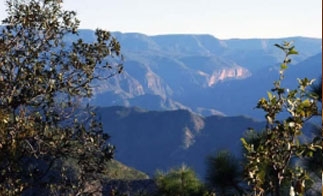An investigation by Mexican newspaper Rio Doce provides a rare look at the difficult life of marijuana farmers in the rugged mountains of Sinaloa.
After some initial difficulty, Miguel Angel Vega, a writer for the Sinaloa-based paper, was able to gain access to the Sierra Madre Occidental Mountains located in the heart of the Golden Triangle, Mexico’s key drug producing region. The region, which spans three of Mexico’s 32 states, is known as the epicenter of marijuana and poppy production in the country. As Vega writes, the region’s rough terrain combined with the inherent danger of the job breeds hardy locals:
To live in the Sierra is to live in a constant state of neglect, where one is always “at the mercy of God.” If you don’t hunt a hare, deer or wild boar, there is hardly any meat to be had, unless you bring something with you from Culiacan. But besides the food, you also have to pay for electricity, oil, clothing, shoes and school supplies for the children; even though one can plant beans, squash and tomatoes, having money is essential to living there.
And yet there is no work to be had, no industry to create jobs, so it is difficult to stay afloat. And that is why locals continue to grow marijuana: despite encroaching signs of civilization like paved roads and electricity, it is the only product they can be sure will sell.
Upon arriving to the area with a guide, Vega sees that nearly all of the locals he met carried weapons, most often a “cuerno de chivo,” Mexican slang for an AK-47. According to locals, a gun is a necessary part of living in the Sierra, serving as protection from wild animals as well as one’s personal enemies. Much like settler communities in the days of the Wild West, bitter and sometimes violent rivalries are common between families in the isolated region, and can date back generations.
Despite their differences, Vega finds that locals share a detailed understanding of the intricacies of marijuana cultivation:
As with any other crop, marijuana requires a lot of care and dedication. From August to September, farmers undertake what is known as the “desmachadero” process, which consists of identifying the male marijuana plants in a plot and cutting them down to prevent pollination of the female marijuana plants. If this is not completed, the crop is ruined.
“If you leave the male plants, they produce these little balls, and these little balls release a dust that gets into the buds [of the female plant]. If that happens, instead of harvesting marijuana buds you harvest seed, and that’s where the crop is ruined,” explains “Pancho,” a farmer that has a plot of more than 50 square meters.
Like him, every local tends to his own little plot, from a 14 year-old boy to a 70 year-old man. They help each other, and if one of them falls behind in their “desmachadero,” the rest of the campesinos get together to lend a hand.
If the “desmachadero” process is carried out successfully, and locals are lucky enough not to have their crop eradicated by soldiers in the meantime, the marijuana is ready to harvest about a month later, in mid-October.
The locals, Vega learns, are only allowed to sell their harvested plants to one buyer, referred to simply as “el señor.” They can make up to 800 Mexican pesos per kilo for high quality marijuana, and as little as 200 pesos per kilo if it has seeds. His curiosity piqued, Vega asks a campesino if this “señor” could be the Señor, Sinaloa Cartel kingpin Joaquin “Chapo” Guzman:
The campesino hesitates slightly before answering, looking around. Finally he explains that while the entire Sierra does in fact belong to Chapo, he is not the one who manages purchases. However the buyers surely knows Chapo, and probably sells all the product on to Chapo Guzman. This man is the one who picks up the grass, and only he knows where he takes it. We just plant it, and if we lose it or if the army destroys it, then there is no money.
As InSight Crime has noted, however, the Sinaloa Cartel’s grip on the Sierra is not unchallenged. In recent months the rival Beltran Leyva Organization has been encroaching into the region in an attempt to increase their access to poppy and marijuana production. Human rights organizations say that the resulting violence has displaced as many as 25,000 rural Sinaloans.
The full article, in its original Spanish, is available at the Rio Doce website.

